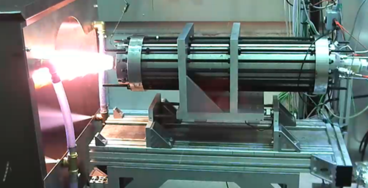hybrid rocket propulsion

Safety, efficiency and actually sustainability are important requirements for sounding rockets. Currently solid rocket motors are mainly used, which are hazardous and potentially highly explosive. In contrast to that, hybrid rocket motors are usually environmentally friendly and safer. In contrast to liquid and solid rocket engines, where both components are either liquid or solid respectively, the oxidiser and propellant in hybrid rocket motors are separated by phase. Hybrid Engine Development at ZARM aims to understand the characteristics of hybrid engines and to develop sounding rocket motors.
This unique combination leads to many advantages compared to other rocket propulsion systems:
Safety - Since the propellant and oxidiser are separated by phase an intimate mixture of the two components is not easily obtained and the possibility of catastrophic events is significantly reduced.
Simplicity - Compared to liquid bipropellant systems the amount of fluid management systems is reduced by a factor of two, since only one liquid (oxidizer) has to be carried into the combustion chamber.
Specific impulse - Hybrid rockets can achieve a very high specific impulse. Even if the choice of propellants is limited, substances that are non-toxic, non-explosive and easy to handle, a specific impulse midway between solid- and liquid propulsion systems can be achieved.
Controllability - In contrast to solid rocket engines, hybrid rocket motors can be throttled and shut down easily at any stage of the flight. The throttling range however is lower than that of a liquid propellant system.
These advantages come at a cost of some disadvantages:
Diffusion limited combustion - The combustion in a hybrid rocket engine is limited by the diffusion of the evaporated solid propellant through the boundary layer into the flame zone, where it mixes with oxidizer stream in the port and combusts. This phenomenon causes a limited mixing, and a fairly large required surface area since the regression rate of the fuel is low.
Low volumetric efficiency - The above mentioned low regression rate requires large surface areas for engines with high thrust. This in turn makes the engines rather bulky compared to liquid propulsion systems.
There are however means to overcome these disadvantages, which range from the right propellant choice with a high regression rate (for example through liquefaction and droplet entrainment) to adapted injector designs and fuel grain modifications.
In addition to these, many technological advances in other propulsion oriented sectors have never been applied to hybrids. This means there is a high potential for innovation and improvement.
One step in that direction is the participation in the STERN (Student Experimental Rockets) program, sponsored by the German Space Administration (DLR). The ZARM contribution will be the ZEpHyR 2 (ZARM Experimental Hybrid Rocket) that will fly from ESRANGE Space Center (Kiruna) using a hybrid rocket engine, which utilizes liquid oxygen as oxidizer and paraffin (candle wax) as fuel.
The complete rocket will be designed, built and tested at ZARM. Therefore the institute offers several laboratories, which also feature a hybrid rocket test stand. It offers the possibility to test hybrid rocket engines with 5000 N thrust and even more. The test stand has the ability to perform tests with several gases like helium, nitrogen, oxygen and cryogenic nitrogen and cryogenic oxygen. Multiple safety components ensure a safe operation. The test facility is remote controlled and equipped with high speed data acquisition systems to monitor feed line and engine parameters.


 "
"